Men's jumpers in the 1990s reflect a dynamic style where oversized fits and bold colors ruled the scene. You'd find cable knits and chunky patterns crafted from warm cotton and wool blends, perfect for layering. Brands like Coogi, Ralph Lauren, and J.Crew shaped the decade's fashion, showcasing vibrant colors and expressive graphics. These unique jumpers often featured patterns like geometric shapes and argyle, celebrating individuality. As vintage styles gain popularity today, you'll want to know how to care for these timeless pieces. The journey through 90s aesthetic continues to reveal fascinating insights into men's fashion you won't want to miss.
Overview of 1990s Styles
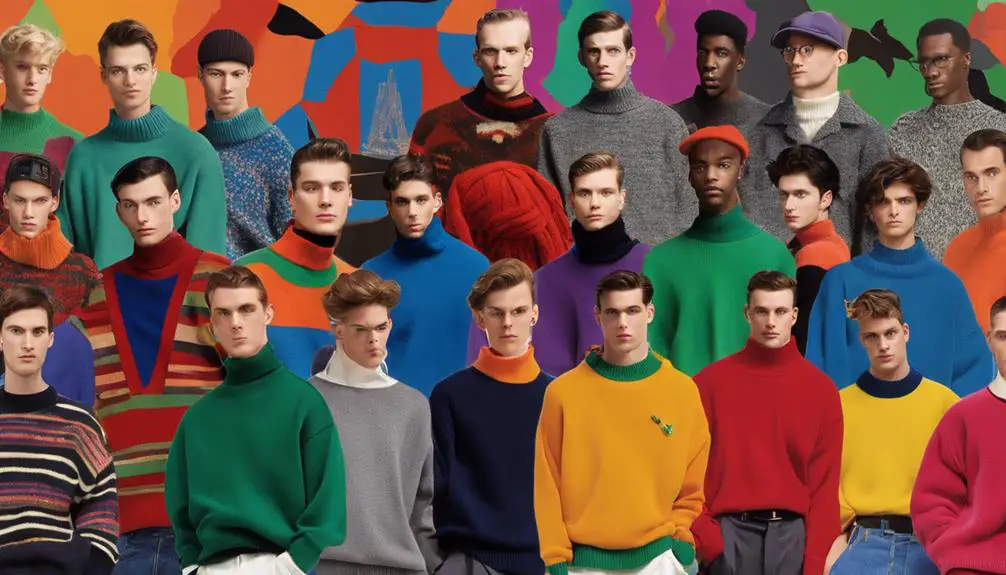
When you think about the 1990s, bold and colorful styles immediately come to mind, especially in men's jumpers that defined the decade's fashion landscape. This era embraced vintage aesthetics, with thrift store finds becoming essential for those seeking unique mens vintage jumpers. The most iconic designs featured oversized fits, allowing for comfort and a relaxed vibe that many gravitated towards. Vintage clothing, characterized by unique designs and craftsmanship, played a significant role in shaping the 90s style, with various labels reflecting the bold trends of the time, including identifying vintage designers. Cable knits emerged as a staple during this time, often crafted from warm wool or cozy cotton blends, making them perfect for layering in cooler months. Additionally, graphic prints became highly popular, reflecting the expressive and casual nature of 90s fashion. Brands like Coogi gained fame for their vibrant patterns, while Ralph Lauren and Tommy Hilfiger dominated the market with their classic American themes and distinct logos.
These jumpers weren't just clothing; they represented a cultural moment, allowing individuals to showcase their personalities through their fashion choices. The combination of bold colors, unique textures, and oversized fits made mens jumpers a defining aspect of 90s style, leaving a lasting impression on fashion trends that continue to resonate today.
Popular Brands and Designers
The popularity of men's jumpers in the 1990s was greatly shaped by several key brands and designers that not only influenced fashion trends but also resonated with the cultural pulse of the decade. Ralph Lauren and Nautica emerged as staples of preppy style, their iconic logos becoming synonymous with the era's fashion. These brands offered jumpers in classic designs, including cable knit patterns, that appealed to a wide audience seeking both style and comfort.
Meanwhile, Coogi gained fame for its bold, multi-colored sweaters that captured the vibrant essence of hip-hop culture. This contrast highlighted the decade's diversity in fashion, where chunky knit designs also found a place, providing warmth and style. J.Crew contributed to the movement by offering casual, classic knitwear that became essential for everyday wear.
Additionally, vintage mens pieces from lesser-known brands like Dockers and Fieldmaster became collectible, showcasing the eclectic mix of styles available. From refined to playful, the 1990s jumper landscape reflected a blend of traditional and contemporary influences, making it a pivotal era in men's fashion history.
Fabric and Material Trends
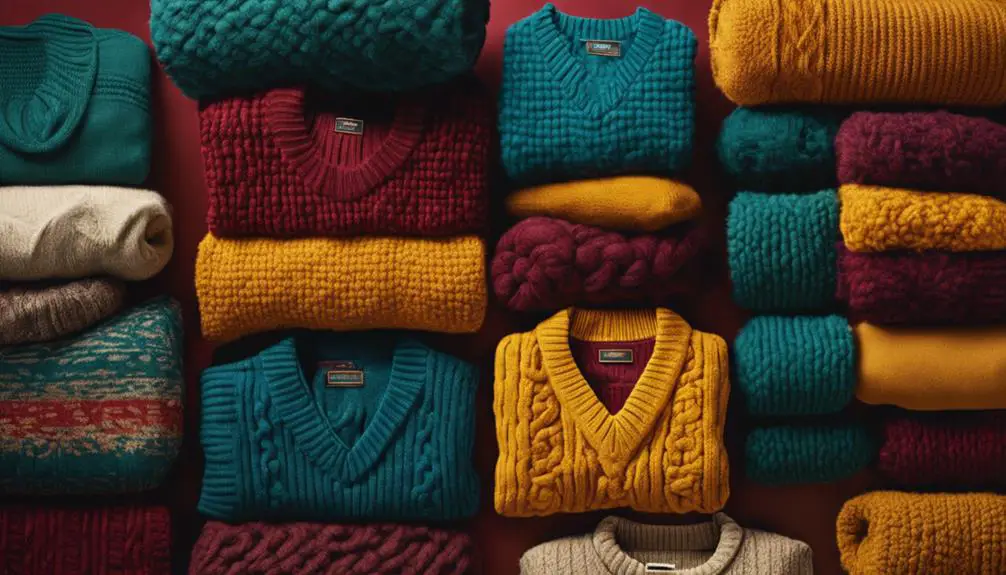
Although the 1990s saw a diverse range of styles in men's jumpers, the fabric and material trends played a crucial role in shaping their appeal and functionality. During this decade, cotton, wool, and acrylic dominated the landscape, often blended to enhance comfort and durability. You'd find that the combination of these materials allowed for versatile sweaters, suitable for both casual and semi-formal occasions.
Chunky knit patterns, especially cable knit and ribbed styles, gained immense popularity. Crafted from heavier fabrics, these jumpers provided warmth while offering a distinct texture that became synonymous with 90s fashion. The era also embraced unique textures and patterns, with marled effects and graphic designs coming to the forefront, making them visually striking.
As casual wear surged in popularity, vibrant colors and playful patterns emerged, exemplified by the iconic Coogi sweaters known for their bold aesthetics. Vintage sweaters from this period often featured specialty designs like argyle and snowflake patterns, reflecting a nostalgic flair. These fabric trends not only defined the era's style but also showcased a commitment to comfort and creativity in men's fashion.
Notable Patterns and Colors
What patterns and colors defined men's jumpers in the 1990s? The decade was marked by bold patterns that made a striking impact on men's fashion. Geometric shapes, color blocking, and oversized graphics created eye-catching pieces that demanded attention. Iconic designs like Argyle and Fair Isle became staples, seamlessly blending into both casual and upscale knitwear.
Vibrant colors dominated the scene, with neon greens, pinks, and yellows reflecting the energetic spirit of the era. These hues weren't just about aesthetics; they represented a cultural shift towards more expressive fashion choices. Additionally, textured knit patterns such as cable knit and ribbed styles added depth and interest, appealing to tactile sensibilities and enhancing the overall visual texture of the garments.
Brands like Coogi emerged as key players, known for their intricate multi-colored designs that celebrated individuality. Their unique approach showcased creativity, positioning men's jumpers as a canvas for self-expression. Fundamentally, the 1990s transformed men's jumpers into bold statements of personality, characterized by a delightful mix of patterns, colors, and textures that continue to resonate in today's fashion landscape.
Fit and Sizing Insights
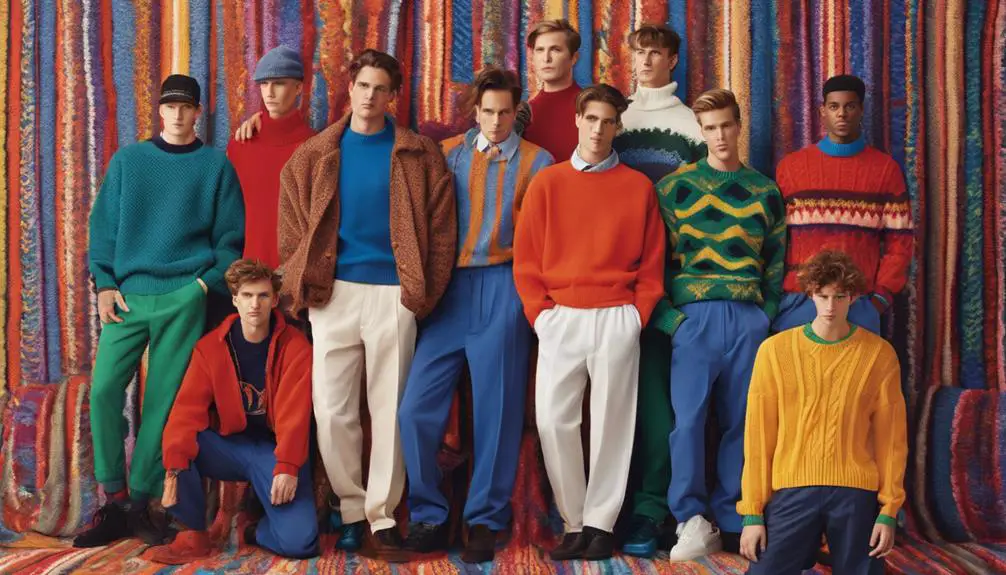
When exploring fit and sizing insights for men's jumpers from the 1990s, you'll notice a distinct shift towards relaxed and oversized silhouettes that defined the decade's fashion. This era embraced a more casual vibe, with jumpers typically available in sizes ranging from Extra Small to 2XL. Chest sizes varied from 35" to 50", and sleeve lengths stretched from 32.5" to 37.5", accommodating diverse body types. Understanding the historical context of vintage clothing labels can also aid in identifying the era and authenticity of these garments.
The relaxed fit and oversized style weren't just trends; they allowed for layering, making these jumpers versatile for various occasions. However, it's crucial to recognize that vintage sizing standards differ considerably from modern ones. To find the best fit, always check the item labels and provided measurements, as many listings include detailed size guides tailored to help you navigate this aspect.
Understanding these insights can enhance your shopping experience, ensuring you select a jumper that not only fits well but also complements your personal style. The emphasis on inclusivity across different designs during the 1990s reflects a broader understanding of body types, making vintage jumpers a genuinely accessible choice for all fashion enthusiasts.
Vintage Market Demand
The vintage market for 1990s men's jumpers is booming, driven by a powerful blend of nostalgia and contemporary fashion trends. You're likely noticing a heightened interest in unique designs—bold graphics and colorful patterns that defined the era. This appeal to both collectors and enthusiasts has led to a surge in demand.
| Brand | Price Range | Features |
|---|---|---|
| Polo Ralph Lauren | $30.00 – $99.99 | Iconic logos, vibrant colors |
| Tommy Hilfiger | $20.00 – $75.00 | Distinctive stripes, casual fit |
| Vintage Knitwear | $17.00 – $60.00 | Unique textures, sustainable option |
In the collector's market, pricing reflects rarity and brand recognition, making these jumpers highly sought after. Online marketplaces have made it easier for you to find these treasures, showcasing an array of styles from well-known brands. Additionally, the increasing popularity of sustainable fashion has positioned 1990s vintage clothing as an eco-friendly alternative to fast fashion. Investing in these jumpers not only connects you to a nostalgic past but also supports a more sustainable future in fashion.
Care and Maintenance Tips
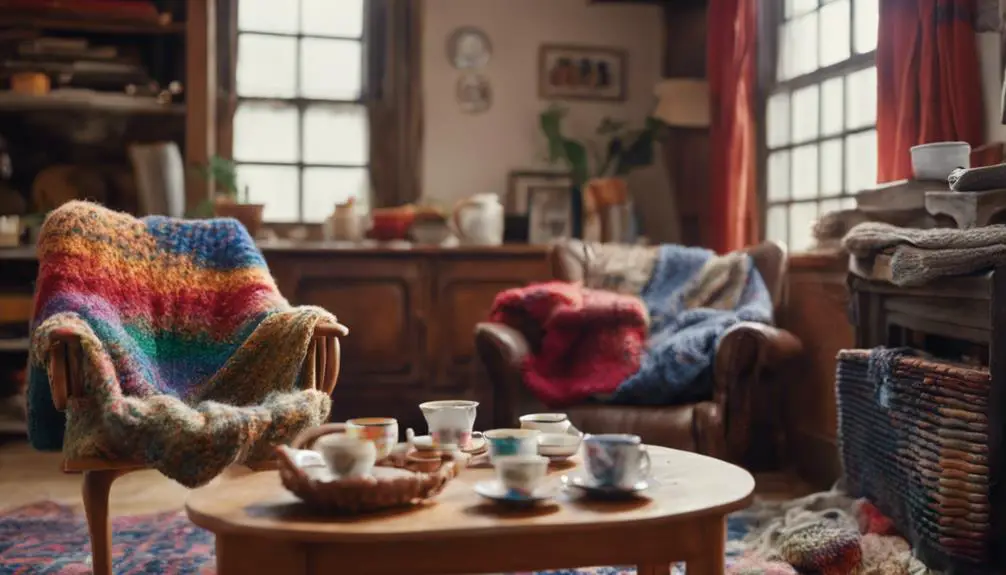
Proper care and maintenance of your vintage jumpers is essential to preserve their unique charm and longevity. Each piece often tells a story, but neglecting their care can lead to irreversible damage. Start by always checking the care label; materials like wool and cashmere typically require hand washing or dry cleaning to maintain their quality. On the other hand, machine-washable cotton or acrylic jumpers should be washed on a gentle cycle with cold water and mild detergent to avoid shrinkage and fading.
Here are three key tips for keeping your jumpers in top condition:
- Avoid Fabric Softeners: These can break down fibers over time, altering the texture of your knitwear.
- Prevent Pilling: Store your sweaters folded rather than hanging. If you notice any pilling, use a fabric shaver to keep them looking fresh.
- Optimal Storage: Keep your vintage jumpers away from direct sunlight and in a cool, dry place. This prevents fading and damage caused by humidity.
Frequently Asked Questions
Did People Wear Sweaters in the 90s?
Yes, people wore sweaters in the 90s. Bold colors, oversized fits, and unique patterns defined them, reflecting the decade's eclectic style. You'd often layer them with other clothing, making them versatile for various occasions.
Can Men Wear Jumpers?
Absolutely, you can wear jumpers! They offer versatility and comfort, easily pairing with various outfits. Whether you're dressing casually or for a more polished look, jumpers can enhance your style and keep you cozy.
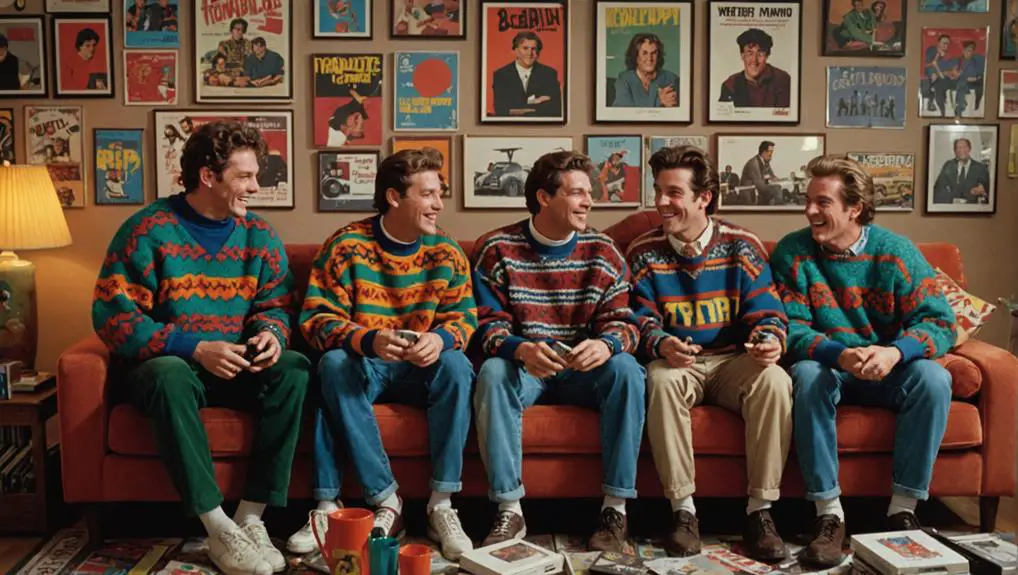

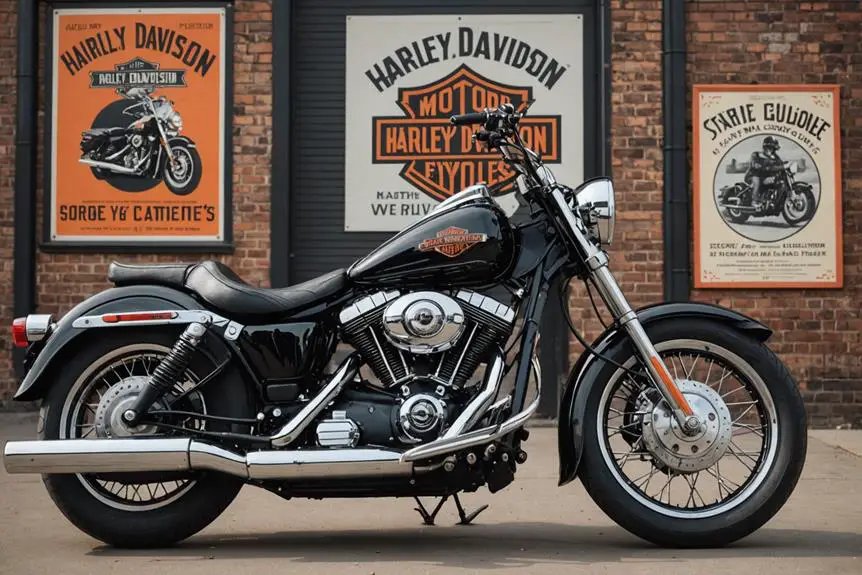

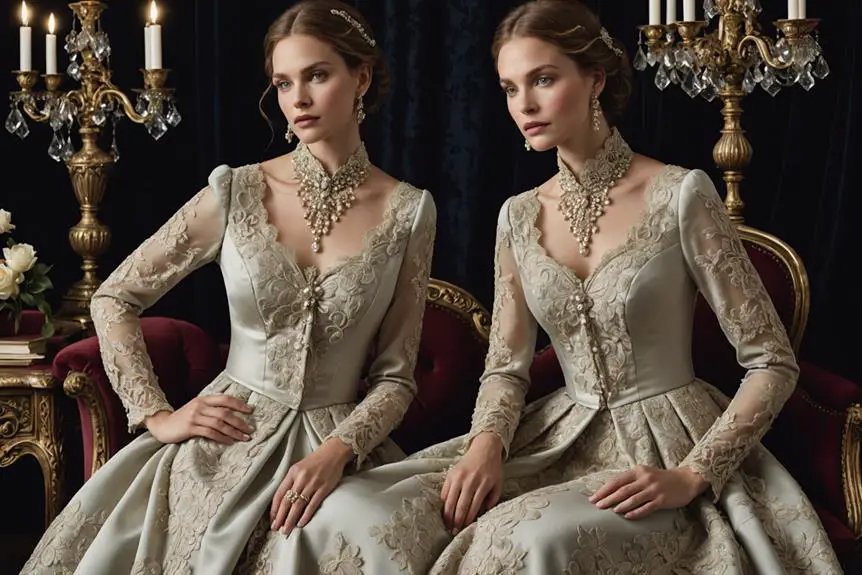
I love reading an article that will make men and women think.
Also, thanks for allowing me to comment!
site
Thanks on your marvelous posting! I actually enjoyed reading it, you can be a great author.I will be sure to
bookmark your blog and definitely will come back very soon. I want to encourage one
to continue your great writing, have a nice afternoon!
casino en ligne
I think this is among the most significant info for me.
And i am glad reading your article. But want to remark on some general
things, The web site style is great, the articles is really great : D.
Good job, cheers
casino en ligne
Spot on with this write-up, I absolutely believe this web site
needs far more attention. I’ll probably be returning to read through more, thanks for the information!
casino en ligne
I’m gone to tell my little brother, that he should also pay a visit this web site on regular basis
to take updated from hottest news update.
casino en ligne
Hello there, I discovered your site by way of Google whilst searching for a similar subject, your site came up, it appears to be like good.
I’ve bookmarked it in my google bookmarks. Hello there, simply become aware of your blog via Google,
and located that it is truly informative. I’m going to watch out for brussels.
I will be grateful when you proceed this in future.
Lots of folks can be benefited out of your writing.
Cheers!
casino en ligne
We’re a group of volunteers and starting a new scheme in our
community. Your web site offered us with useful info to work on. You’ve done a formidable process and our
whole group can be thankful to you.
casino en ligne
We stumbled over here from a different web address and thought
I should check things out. I like what I see so i am just following you.
Look forward to looking over your web page again.
casino en ligne
Hi my loved one! I want to say that this post is awesome, great
written and include almost all significant infos. I’d like to peer more posts like this
.
casino en ligne
I am really impressed with your writing skills as well as with the layout on your blog.
Is this a paid theme or did you customize it yourself?
Anyway keep up the excellent quality writing, it is rare to see a great blog like this one nowadays.
casino en ligne